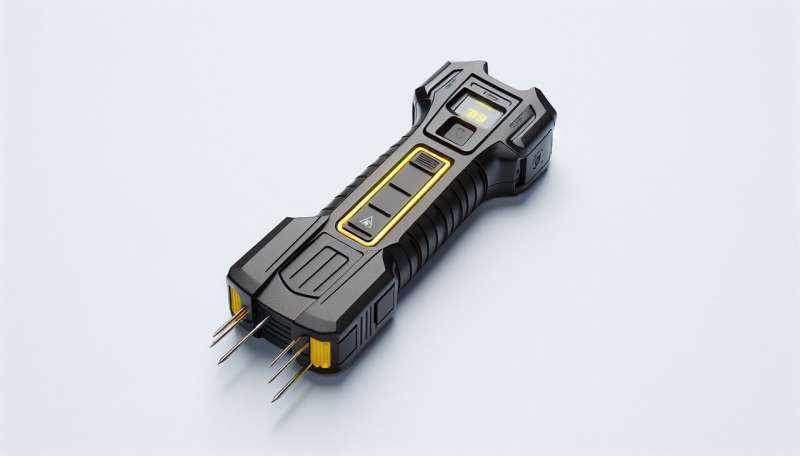The truth about Tasers: What UK statistics and research tell us

Prime Minister Keir Starmer recently the police to take "all necessary action" in response to unrest across cities and towns in England and Northern Ireland.
One of the most tools at the police's disposal is the Taser—a conducted energy device designed to temporarily incapacitate people with an electrical shock.
Bright yellow and handheld, a Taser can be used in two ways: by direct contact or by firing from a distance. The device's probes are engineered to pierce a person's clothing and skin, delivering an electrical charge intended to de-escalate potentially volatile situations.
Tasers were first introduced to British policing in 2003, to between using sprays and firearms in handling serious and violent incidents. Initially limited to trained firearms officers, the use of Tasers was expanded in 2008, allowing all officers to receive specialized training in their deployment.
By 2019, of officers across England and Wales were trained to carry and use Tasers. And by 2023, of officers in the Metropolitan Police were trained to carry and use them.
Since 2019, student police officers have been allowed to carry Tasers, following a from the National Police Chiefs' Council. The council acknowledged that student officers face the same risks as fully trained colleagues, already carry batons and irritant spray, and account for a considerable proportion of front-line officers.
The most recently published show that between April 2022 and March 2023, Tasers were used (including being drawn and aimed at a person) 33,531 times in England and Wales, and actually fired 2,978 times. This is a decrease from 2021 to 2022, when Tasers were used 34,276 times and fired 3,212 .
In Scotland, only specially trained officers can use Tasers. Between 2018 and 2021, they were in 782 Scottish incidents. The human rights organization Amnesty the Police Service of Northern Ireland earlier this year for its increased use of force, including a 40% increase in Taser use.
Guidance for how police in England and Wales should use Tasers is by the College of Policing. It states that they should only be used as a proportionate response to an identified threat. Officers should provide the clear verbal warning "Taser, Taser" and, if circumstances allow, give sight of the device before firing.
Police Tasers in response to weapon possession, drug use, or the need to protect themselves or others. But age and gender also play a role. People aged between are the most frequent targets of Taser use, while being a reduces the likelihood of being tasered by 80%.
The data on Tasers and race is inconsistent, however. have found that Tasers have been used on non-white people as white people, while others have found .
What do the public think?
Public support for police carrying Tasers is strong. A of more than 9,000 people in 2016 found that 79% backed the idea of more officers being equipped with Tasers. A 2019 survey of more than 4,000 people revealed that 66% would feel if every officer in their community carried a Taser, and 69% trusted the police to use them responsibly.
A conducted during this summer's riots revealed that 75% of Britons believe Tasers should be used in such situations. Among the police, support for wider Taser use is even stronger—90% of more than 8,000 officers agreed that more of their colleagues should be equipped with the device.
However, the Independent Office for Police Conduct (IOPC) warns that Taser use can significantly affect public confidence in the police, partly due to misunderstandings about how and when Tasers are deployed. The IOPC points to a between public expectations and the actual situations in which Tasers are used, particularly when vulnerable individuals are involved.
Concerns about Taser use
Tasers can inflict pain and cause neuromuscular incapacitation, leading to a person stiffening up and collapsing, unable to control their movements. This sudden loss of control can result in injury.
Additionally, the probes penetrating the skin carry a risk of infection and, potentially, the transmission of . In rare cases, Tasers can flammable clothing, causing burns. And there's also a risk of , and even death.
Although Tasers are to de-escalate threats or temporarily incapacitate people, the IOPC has cases where Tasers were discharged for prolonged periods.
Mental health issues or acute behavioral disturbances are often present in cases where a Taser is discharged for 20 seconds or longer. Research indicates that people with mental health issues are to be tasered.
Police have also used Tasers on children, with more than 3,000 instances involving between 2022 and 2023 in England and Wales. In 88 of those cases, the weapon was actually fired.
In the same period, Tasers were drawn on six children under the age of 11. While Taser use is often linked to the possession of a weapon, the Children's Rights Alliance for England has called for a on using the device against children.
Tasers are considered a for both police officers and the people involved, causing fewer injuries than dogs, batons, physical force or spray. But some high-profile cases—such as a in south Wales who miscarried days after being Tasered—have shown that significant risks remain.
The IOPC's from its 2021 investigation emphasize the need for improved training and guidance, increased scrutiny and monitoring, and greater community engagement.
Provided by The Conversation
This article is republished from under a Creative Commons license. Read the .![]()
















